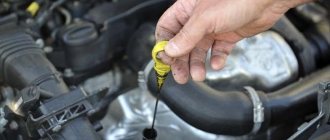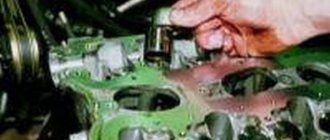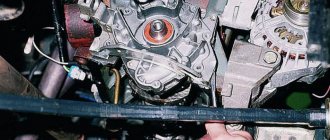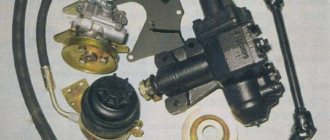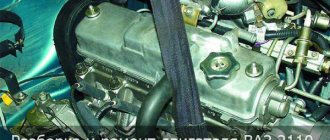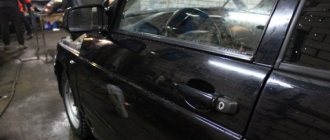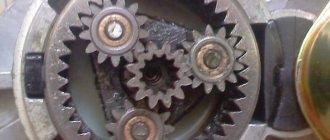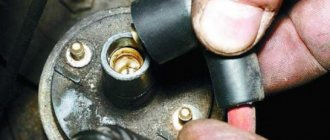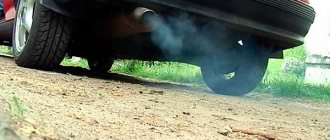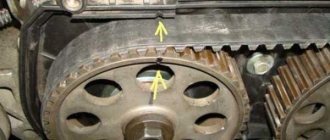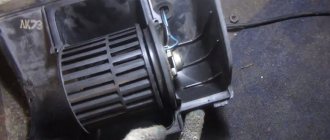- Car make: 2114 (Chepyrka)
From: Peter
Guys, tell me. VAZ 2112 1.5 16kl jerks when accelerating. There is no such thing in cold weather. I changed the spark plugs. Oh yes, sometimes he shoots at the silencer. Who thinks what?. VAZ 2110 16 valve engine 1 5 twitches during acceleration.
Similar articles
47 comments on “Vaz 2110 16 valve engine 1 5 jerks during acceleration. 5 16kl jerks when accelerating”
The ignition needs to be adjusted...
Rail, the marks are in place
Is the rail pressure normal? Is the fuel pump ok?
DMRV, it was exactly the same, I changed everything, all the sensors, but the problem turned out to be that -))) I didn’t show the error as if it were evil)
Ruslan, today I changed the DMRV without any changes
Roman, I changed the Bosch pump a month ago
My VV wires have deteriorated and my power supply is flawed
This kind of nonsense can also happen with a dying ignition module
There may be wires. Start the car in the dark and see if there are sparks, then change it. I had the same thing. The diagnostics didn’t show anything and I changed the fuel, but it still jerked, but I changed the wires and it stopped.
Check the high voltage wires. One wire was broken and it was exactly like yours.
Alexander, I don’t know if it’s true or not, but you need to select the air flow sensor according to the table on the Internet, that is, according to your own brains, when I bought a new one in the store I didn’t know about it, I installed a new one and nothing changed, as it turned out, I installed the air flow sensor 116, but I should have 037, I changed it and lo and behold, everything is normal, outwardly they are no different, but 116 also determines the air temperature, check, my brain is January 5.1.2, the engine is the same as yours.
CHANGE THE IGNITION MODULE IT WAS THE SAME CRAP
Ruslan, 037 is a DMRV for half a ruble 116 1.6
Andrey, I changed it today
Roman, changed it today
Well, I had a problem with it)))
Dimoss, yesterday I went to the dacha, opened the soot, looked and didn’t see anything
Alexander, try changing them, they cost 300 somewhere
Dimoss, we have 700 :)
Answer: VAZ 2110 16kl. jerks when moving!
if, with a sharp increase in speed, the engine choke (as if it first fails, and then smoothly picks up speed with a twitch), probable reasons: -1 (and the most probable) IGNITION COIL! (if you don’t have a coil per cylinder, but one large block with a built-in switch. And it sits on top of the engine, it appears more often when it’s hot) -2 Air flow sensor. (You can actually check it either with a scanner or by replacing it) -3 Pressure in the fuel line (should be 2.7-3.5, or simply at least be dumped into the return line) ) -4 high-voltage wires (just check the resistance) -5 injectors are clogged (well, then wash it.)
As a rule, other options with sensors provoke the recording of errors in the computer by these sensors, and with the above listed, errors may be recorded for misfires in the cylinders, and precisely in those where the non-working part of the cylinder (the coil consists of two modules) 1-4 or 2 -3. or where the injectors are clogged.
The car jerks - check the spark
Often a car malfunction is associated with the formation of a spark, which is why it begins to behave strangely.
The easiest way to identify this problem is when descending from a hill or on a fairly flat area. To prevent this cause, it is necessary to check the spark plugs (VAZ-21124). If they fail, overheat or become unstable, replace them. The price of spark plugs (VAZ-21124) is about 700 rubles per set.
So, what should you do if the car starts to jerk when you press the gas. In order to fix the problem, you will have to find it first. For example, if the car runs on gas, the problem may lie in the vacuum regulator.
Answer: VAZ 2110 16kl. jerks when moving!
then make it simpler: -1 check for the presence of gasoline in the return line, i.e. after the reduction gear. if it’s not there, then screw the pump; if there’s a good flow, then everything is ok. and the filter has nothing to do with it.
-2 if there is gasoline in the return line, pinch it (even with pliers) and try to rev it up. If the dips go away, or become much smaller, then the injectors are clogged. If the dips remain the same, then there are two options: the woman or the data flow. air
-the engine can be checked either with a known good spark plug, but with a large gap, for a spark, each cylinder, starting the engine (you will understand everything by the difference in the spark) or check the resistance on the secondary of both modules, preferably when hot (should be the same), although at the same time There may be a glitch in the primary, but you can’t just measure it, so it’s better to check for a spark.
The reason for the twitching is the control unit
The supposed cause of the jolts lies in the gear shift. It is quite difficult to understand the essence of twitching.
Therefore, if you notice that the VAZ-21124 twitches when accelerating or driving, it is better to contact a car repair shop for diagnostics. The auto center will easily help you determine the cause, since it is much easier to see the problem on a lift. The movement of the car at idle allows you to understand not only why the car is constantly pushing, but also to track the smoothness of the revolutions. Sometimes this problem is much more complex than it seems, and to detect it, you will need to create special operating conditions, which is completely impossible to do while driving.
Why does the VAZ 2110 jerk when driving?
The phenomenon, which car enthusiasts call jerking, occurs due to a sudden change in the crankshaft speed when the gas pedal is in a stable pressed position. If suddenly a VAZ 2110 jerks while driving, this causes anxiety and concern to the car owner.
We need to do something urgently, but first we need to understand the reason. We will talk about some features of jerks and signals that help you understand why they occur.
During the start
Most often, when starting from a standstill, the highest stage of the jerk is observed - failure, that is, a very significant delay in the engine’s response to the pressed gas pedal. It happens that the engine stalls. It’s especially unpleasant when you’re standing, for example, in front of a traffic light, and someone behind you is already honking, and you’re frantically starting the car again.
A jerk when starting off occurs when the ECU (electronic control unit) gives a signal to start opening the throttle valve, that is, when transitioning from the XX mode to the driving mode.
Throttle position sensor
IN THIS WAY, THE QUANTITY OF FUEL SUPPLY THROUGH THE INJECTORS SHOULD INCREASE, WHICH DOES NOT OCCUR WHEN THE PRESSURE IS INSUFFICIENT IN THE FUEL LINE.
Potential culprits for the car moving jerkily when starting off:
- fuel pump , which is about to completely fail. This is evidenced by its peculiar periodic “howling” or an increase in its noise. The pump on an injection engine is listened to even before the engine itself is started - it is turned on initially from the battery, starting to pump fuel before turning on the starter. It is located inside the gas tank, so it becomes almost inaudible once the engine is running. In carburetor cars, the fuel pump is under the hood, you can hear it even when the engine is running;
- The fuel pump mesh is clogged with foreign particles that enter the gas tank along with low-quality gasoline at the gas station, or are formed in the tank itself due to condensation. This is why the gas tank should be flushed periodically;
- fuel filter , which is located under the hood. It also needs to be changed periodically;
- pressure regulator To replace it, you will need to remove and disassemble the fuel pump.
The first step is to check what pressure the fuel supply system produces. The check is carried out using a pressure gauge. It connects to a fitting located on the fuel rail (under the hood). We cannot give uniform readings, since it is different on different engines.
For some, a pressure below 325 kPa can be considered normal, while for others it is 400 kPa. That is, you need to look specifically at your instruction manual.
If the pressure gauge readings are too high, it means there is a malfunction in the fuel pressure regulator. If the readings are too low (less than 284 or 364 kPa, again, depending on the engine), replacing the fuel filter will help.
Reasons for unstable operation of the VAZ-2112 at low speeds
General view of the 12-series engine There are not many reasons that accompany the appearance of the twitching effect at low speeds. We can even say that everything is tied to the fuel supply system to the cylinders. So, it is necessary to identify all the reasons that are associated with the problem on the car:
- The problem is hidden in the fuel system.
- Incorrect throttle operation.
- The crankshaft sensor has failed.
- ECU.
Perhaps the reason for the car jerking is worth looking for here. When all the problems have been identified, it is worth moving on to searching for solutions to the problem.
While driving
It is also an unpleasant situation when the car has jerks and dips during acceleration. This can happen both when driving and when starting off. A particularly unpleasant, or even dangerous, situation can arise while driving, for example, when a car is about to overtake, and then there is a sudden failure.
The causes of jerks during acceleration can be both those already mentioned and slightly different ones:
- If you have a carbureted car that jerks when accelerating, this may indicate that the ignition is too early. You need to set the lead angle. And checking the ignition timing is quite simple: at speed 4, accelerate to 50 km/h and brake sharply. If detonation lasts 1-2 seconds, then the ignition is set perfectly, the reason is not there;
- on “injectors” everything is controlled electronically. There, the jerking while driving and during acceleration may be due to the mixture being too lean. But this should be shown by diagnostics in the service. If the sensors “know about this, but are silent,” then it is quite possible that they themselves are faulty and must be replaced.
How to cure a car?
First you need to diagnose the fuel pump:
- remove the cover from it and carefully inspect visually, paying special attention to the area near the valve;
- If there is no o-ring, take corrective action.
In this case, the fuel pump depressurized and interruptions in the fuel supply began to occur. This is exactly what is causing the car to malfunction. After the seal is restored, the VAZ-21124 (16 valves) will begin to move smoothly along the road again. You can replace the O-ring yourself, the main thing is to find the right ring and tools.
Jerks when cold
Many owners of the VAZ 2110 note that jerks occur when cold, and after warming up, the car gets into a rhythm while driving and stops “sausaging”. The main reason in this case is called a lean mixture, due to the fact that air is sucked in at idle. Or one of the sensors “died”.
If dips often occur when cold (as well as when driving), in addition to everything already listed, you need to check:
- spark plugs - if they have heavy carbon deposits, and even make poor contact with the wires, this needs to be corrected urgently. In the first case - by replacement, in the second, by cleaning and strengthening contacts;
- high voltage wires . Checked with an ohmmeter (multimeter). But if they even look old and shabby, it’s better to just replace them all at once;
- ignition coil . You need to check the armored wires and the ignition module while wearing rubber gloves, otherwise you may get a slight electric shock if there is a break;
- The timing belt can jump a couple of teeth, then when cold there may well be failures. Therefore, check whether the marks on the pulleys match. If not, the belt must be removed and set correctly;
- be sure to check the oxygen sensors (OS); mass air flow (MAF); idle air regulator (IAC), if a malfunction is detected, replace them;
- filters . In principle, they need to be checked first, even before serious damage occurs. Air and fuel filters are designed to give cars a clean mixture. That is, they take on all the debris particles, so they become clogged, worsening the dynamics of the car, and also increasing fuel consumption. They need to be changed regularly.
IF YOU HAVE CHECKED EVERYTHING, TRIED TO FIX IT, BUT NOTHING HELPS, YOU SHOULD ONLY SEEK THE REASON IN THE ENGINE ITSELF.
It is possible that the fuel injectors in a fuel-injected vehicle are clogged. Then you will need professional diagnostics in the service.
Communities VAZ Repair and Modification Blog 12shka twitches standard treatment or unexpected reasons
Replacing the cylinder head gasket of a VAZ-2112 16 valves with your own hands
Hi all. I decided to share a couple of observations in solving this problem. Quite recently on a community forum I asked the following question: the VAZ 2112 1.5 16v began to twitch at low speeds. 1-2 plugs and then picks up speed. Getting started was a real problem. The trouble did not arise abruptly. During the winter she came out and left from time to time. Over the last 2 weeks it has become constant. Plus, dullness of acceleration at medium speeds was added and, as a result, consumption was a plus. In general, the decision was made to replace the fuel filter. Well, I decided that there was no point in carrying out a replacement without inspecting the fuel pump and the mesh on it. According to the ABC book, I relieved the pressure in the system by removing the pump terminal and starting the car, and then took out the pump.
In general, after that I replaced the filter which, for obvious reasons, was up to its ears in dirt. I noticed an interesting nuance here. Before starting work, when I started the car to relieve pressure in the system, the car worked for at most 10 seconds, then I turned it purely with the starter as written in the book. The second time I had to release the pressure when a new filter and mesh were already in place. (The tube on the filter was leaking) So the second time the machine worked for 40 seconds! It responded perfectly to the gas pedal. Even when in doubt, I checked whether the pump terminal was disconnected. After that, it started up three more times and ran for about 10 seconds. And even after that, there was a little pressure left in the system. In general, this is how you can check the condition of the filter
If a car without a terminal on the pump stalls quickly, then you need to pay attention to the filter and the fuel pump. In short, I collected everything, drove it for a drive, the car became faster, but the failure did not go away. With the car running, if you jerked the throttle valve sharply, the engine seemed to choke at first and only then picked up speed
I checked all the sensors, cleaned the brain terminal, checked the air filter. Well, I decided to try changing the spark plugs. I started to remove the wires from them and I was confused that on the old wires, when I put them on and took them off, I could clearly hear the ringing click of the contact being put on. Nothing like this was heard on the new wires. I decided to test a stupid idea and threw in an old set of high-voltage wires and... everything disappeared! The engine began to respond instantly to the throttle and began to run smoother at idle. I was very surprised, I didn’t think that there could be a failure in any section of the gas. I would never have thought of them. To check, I installed new wires and the failure appeared again. After 2 days of driving, I clearly felt the return of traction at low speeds and the absence of failure at medium speeds, and no failures. In general, this is such a mysticism. I decided to share the information with you, maybe it will be useful for someone.Z, Y. I worked in the rain and was not in the mood to take pictures at all. Therefore, for clarity, I dug up photos on the net.
Z.Y.Y. I completely forgot! Don't forget to relieve pressure in the system! There are 2.5 kilograms! With such pressure, a gasoline shower is provided for the entire cabin. and even after resetting, I would advise unscrewing the filter tubes with glasses. The residual pressure just splashes into your eyes. Throw on any old glasses and you will look stylish in the process and your eyes won’t get hurt :):):):)…like mine
conclusions
As can be seen from the above, there are quite a few reasons for the machine twitching during its operation.
And you don’t necessarily need to be an expert in automotive matters. Anyone can fix minor breakdowns in their car. If you notice strange behavior of the car, including jerking and jerking, you should definitely seek advice from a car service center or ask automotive professionals who have more than one year of practice behind them.
More than once, drivers encounter a problem when a VAZ-2112 begins to stall and twitch when accelerating. What is this connected with? The reason that unites all the factors remains the wrong gasoline mixture or its poor quality.
The video shows symptoms and treatment methods when the car jerks:
A front-wheel drive car of the VAZ family is considered.
Main reasons
General view of engine 2112 16 valves
There are not many reasons why a car may twitch during acceleration, but motorists should know them. So, let's look at what problems contribute to this effect appearing :
- Poor quality gasoline.
- The problem is in the fuel pump or fuel system.
- Failure of the mass air flow sensor.
- Damage associated with the throttle valve.
- The malfunction is hidden in the ignition.
- The fault lies in the ECU.
The car twitches - methods of elimination
In order to eliminate the car jerking during acceleration, you will have to check each of the following systems step by step. Thus, a lot of work will need to be done. Therefore, some knowledge of engine design and other automotive systems will be required. So, let's consider the sequence of nodes in which a malfunction could occur that caused such an effect.
Poor fuel quality
A canister with a negative smiley face means low-quality gasoline
As you know, there are too many fakes on the modern petroleum products market. But this is not the worst thing, but the impurities and water contained in gasoline can lead to disruption of the engine, namely the fuel supply and injection system. Of course, at a gas station it is impossible to check the quality of gasoline that enters the fuel tank. So, even at proven and reliable gas stations you can run into low-quality fuel. The only way to protect yourself is regular diagnostics of systems. It is better to pay several times for inspection than once for repairs.
Fuel system
Fuel system diagram with explanation
As mentioned above, low-quality fuel causes clogging of the injection system. So, the fuel filter, gasoline pump or injectors may fail . Often, it is the latter malfunction that causes the car to begin to twitch during acceleration. Eliminating the cause is quite easy; to do this, you need to diagnose the fuel pump and replace the fuel filter. It is also recommended to clean the injectors or replace those that are faulty.
Mass air flow sensor and throttle
Mass air flow sensor
The DMVR and the throttle valve are inextricably linked, so diagnosing the condition of these elements should be carried out by everyone together. So, if necessary, it is worth replacing the mass air flow sensor or cleaning the throttle. This may help, but not always.
Ignition
Ignition system kit spare parts
Experience shows that an acceleration problem may be hidden in the ignition system. In order to correct the malfunction, it is worth diagnosing the spark plugs and high-voltage wires, where the problem may lie. For the first, you need to unscrew them from the block and look for the presence of carbon deposits or oil in the spark plug wells. If necessary, replace the spark plugs, after reading the article on selection and then checking the gaps using a special feeler gauge.
High-voltage wires should be checked for breakdowns or damage to the ignition.
So, for diagnostics, a tester is used that checks the resistance of each wire. If it is discovered that one BB wire has failed, it must be replaced. The manufacturer recommends replacing all wires in one set, having first checked them with a multimeter.
ECU errors
List of engine control unit errors
So, to fix the problem you will need to reset all the errors that have accumulated. If this does not help, then you should change the firmware. This type of problem elimination only works when all other causes have been eliminated, but the effect remains.
